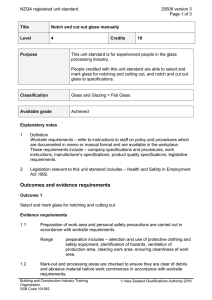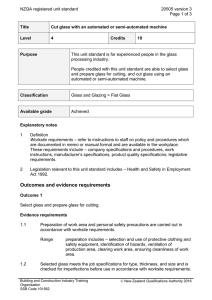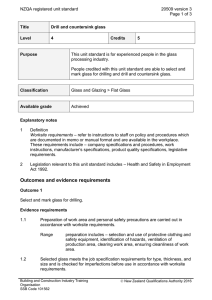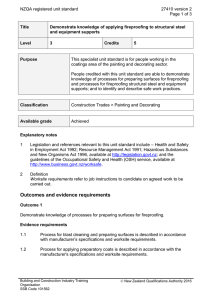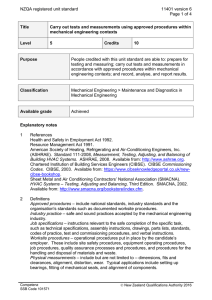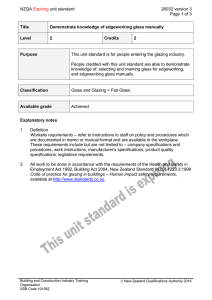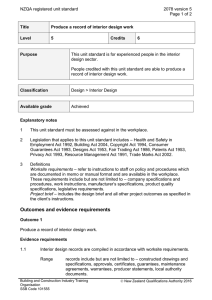NZQA registered unit standard 2051 version 6 Page 1 of 4
advertisement
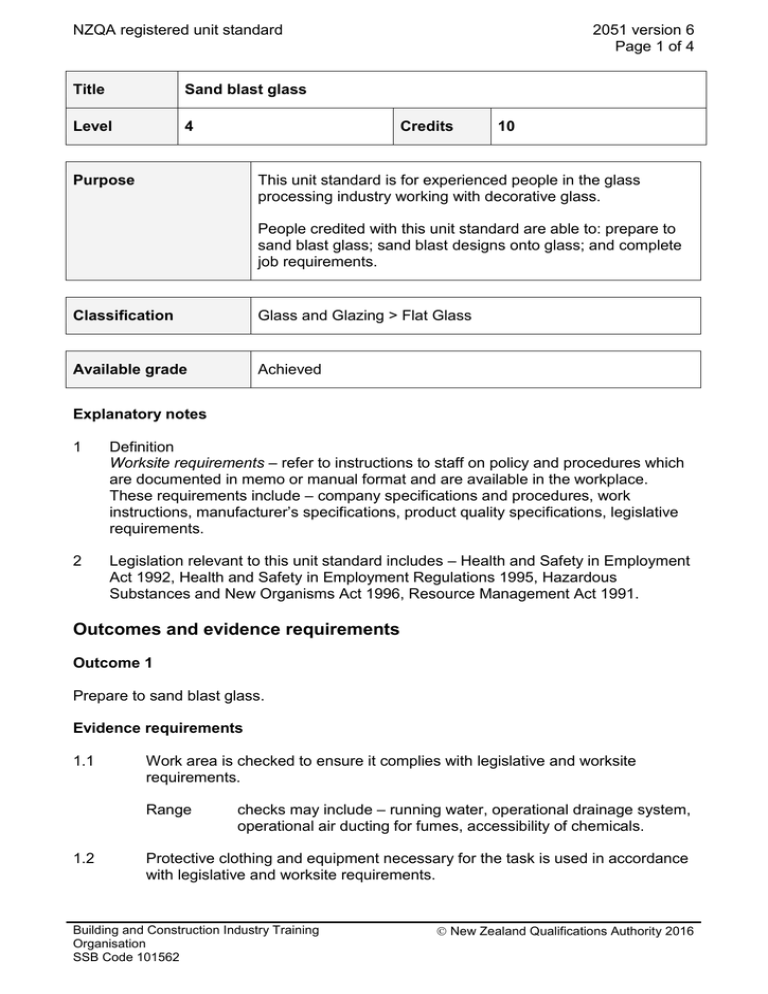
NZQA registered unit standard Title Sand blast glass Level 4 2051 version 6 Page 1 of 4 Credits Purpose 10 This unit standard is for experienced people in the glass processing industry working with decorative glass. People credited with this unit standard are able to: prepare to sand blast glass; sand blast designs onto glass; and complete job requirements. Classification Glass and Glazing > Flat Glass Available grade Achieved Explanatory notes 1 Definition Worksite requirements – refer to instructions to staff on policy and procedures which are documented in memo or manual format and are available in the workplace. These requirements include – company specifications and procedures, work instructions, manufacturer’s specifications, product quality specifications, legislative requirements. 2 Legislation relevant to this unit standard includes – Health and Safety in Employment Act 1992, Health and Safety in Employment Regulations 1995, Hazardous Substances and New Organisms Act 1996, Resource Management Act 1991. Outcomes and evidence requirements Outcome 1 Prepare to sand blast glass. Evidence requirements 1.1 Work area is checked to ensure it complies with legislative and worksite requirements. Range 1.2 checks may include – running water, operational drainage system, operational air ducting for fumes, accessibility of chemicals. Protective clothing and equipment necessary for the task is used in accordance with legislative and worksite requirements. Building and Construction Industry Training Organisation SSB Code 101562 New Zealand Qualifications Authority 2016 NZQA registered unit standard Range 2051 version 6 Page 2 of 4 protective clothing and equipment includes – overalls, full face mask, gloves, protective apron. 1.3 Any potential hazards are identified and preventative measures are taken in accordance with legislative and worksite requirements. 1.4 Safety check of machinery and equipment is completed prior to use in accordance with manufacturer's and worksite requirements. 1.5 Any faulty or non-operational machinery or equipment is fixed or replaced in accordance with worksite requirements. 1.6 Grade of grit is selected in accordance with type of glass, the job specifications, and worksite requirements. 1.7 Air pressure is set in accordance with manufacturer's and worksite requirements. 1.8 Glass is selected in accordance with the job specifications and worksite requirements. Outcome 2 Sand blast designs onto glass. Evidence requirements 2.1 Glass is masked ensuring no air bubbles are trapped under tape in accordance with worksite requirements. 2.2 Design is completed in accordance with the job specifications and worksite requirements. Range design includes – hand cut pattern, computer cut stencil. 2.3 Design is transferred onto prepared masked surface in accordance with worksite requirements. 2.4 Masking is removed and glass is sand blasted in accordance with the job specifications and worksite requirements. Range job specifications may include – full coverage, standard of image, standard of edges, depth of cut. Outcome 3 Complete job requirements. Evidence requirements 3.1 Sand blasted glass is cleaned and stored in accordance with worksite requirements. Building and Construction Industry Training Organisation SSB Code 101562 New Zealand Qualifications Authority 2016 NZQA registered unit standard 2051 version 6 Page 3 of 4 cleaning includes – grit-free, blow-dried, stacked, marked, free of masking material. Range 3.2 Completed work meets the job specifications and customer’s requirements. 3.3 Machinery, equipment and materials are cleaned and stored in accordance with manufacturer's and worksite requirements. 3.4 Post-processing clean-up ensures work area is left free of debris in accordance with worksite requirements. 3.5 Work is completed without injury to personnel and damage to product. Planned review date 31 December 2020 Status information and last date for assessment for superseded versions Process Version Date Last Date for Assessment Registration 1 11 June 1995 31 December 2013 Revision 2 5 February 1997 31 December 2013 Revision 3 20 December 1999 31 December 2013 Review 4 27 April 2004 31 December 2013 Review 5 19 June 2009 31 December 2017 Review 6 18 June 2015 N/A Consent and Moderation Requirements (CMR) reference 0048 This CMR can be accessed at http://www.nzqa.govt.nz/framework/search/index.do. Please note Providers must be granted consent to assess against standards (accredited) by NZQA, before they can report credits from assessment against unit standards or deliver courses of study leading to that assessment. Industry Training Organisations must be granted consent to assess against standards by NZQA before they can register credits from assessment against unit standards. Providers and Industry Training Organisations, which have been granted consent and which are assessing against unit standards must engage with the moderation system that applies to those standards. Requirements for consent to assess and an outline of the moderation system that applies to this standard are outlined in the Consent and Moderation Requirements (CMR). The CMR also includes useful information about special requirements for organisations wishing to develop education and training programmes, such as minimum qualifications for tutors and assessors, and special resource requirements. Building and Construction Industry Training Organisation SSB Code 101562 New Zealand Qualifications Authority 2016 NZQA registered unit standard 2051 version 6 Page 4 of 4 Comments on this unit standard Please contact the Building and Construction Industry Training Organisation info@bcito.org.nz if you wish to suggest changes to the content of this unit standard. Building and Construction Industry Training Organisation SSB Code 101562 New Zealand Qualifications Authority 2016
